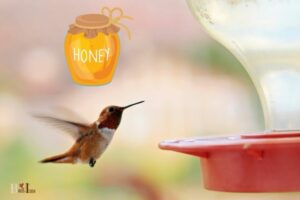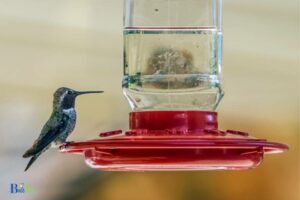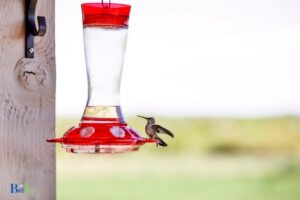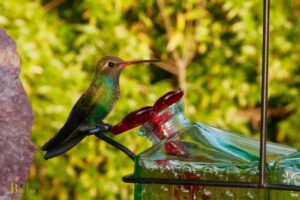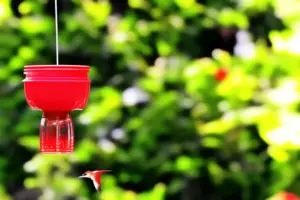Do Bats Drink From Hummingbird Feeders? Yes!
Yes, bats can drink from hummingbird feeders.
Bats, specifically nectar-feeding bats, may drink from hummingbird feeders as they are attracted to the sugar water and can access it just like hummingbirds do.
Although it’s uncommon, nectar-feeding bats, like the lesser long-nosed bat, can drink from hummingbird feeders as an easy source of nectar.
While this may seem surprising, it’s essential to recognize that these bats play a vital role in pollination, similar to hummingbirds.
If you don’t wish to have bats visiting your feeder, simply bring it inside during the night when most bats are active.
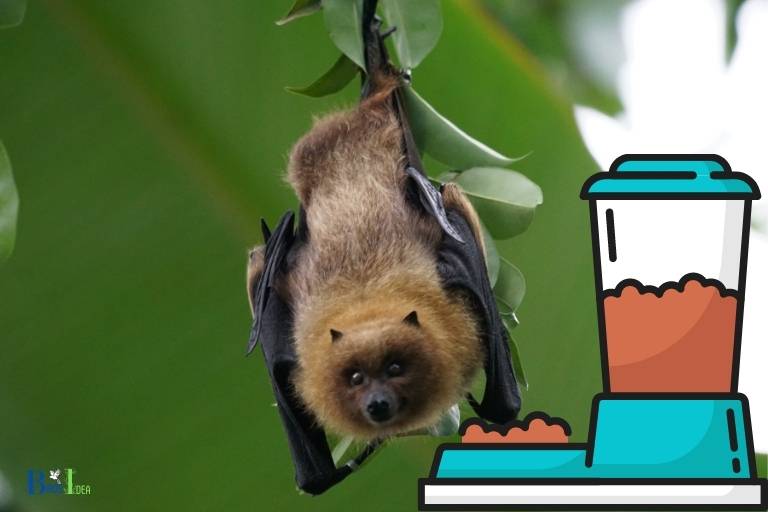
7 Benefits: Bats Drink From Hummingbird Feeders
| Benefits | Details |
|---|---|
| Bats Drinking From Feeders | Yes |
| Species of Bats | Nectar-feeding bats, such as the Lesser Long-nosed bat and the Mexican Long-tongued bat |
| Time of Activity | Nighttime, often after hummingbirds have gone to roost |
| Geographic Regions | Common in the southwestern United States, Mexico, and Central America |
| Impact on Hummingbird Feeders | Can drain or contaminate the nectar, causing hummingbirds to avoid the feeder |
| Preventing Bats From Accessing Feeders | Take feeders indoors at night, use bat-resistant feeder designs, or use feeders with small perches and short feeding tubes |
What Is The Risk Of Bats Drinking From Hummingbird Feeders?
Bats drinking from hummingbird feeders can pose several risks to both the hummingbirds and the bats themselves.
While it might seem like an interesting interaction to observe, it can lead to some unintended consequences.
The risks associated with this activity include the transmission of diseases, competition for resources, and potential harm to the bats.
- Disease transmission: Bats can carry various diseases, including rabies, which they can transmit to other animals while feeding. Additionally, the saliva of bats can contaminate the feeder and make hummingbirds susceptible to infections.
- Competition for resources: Bats are known to consume large amounts of nectar, which can quickly deplete the resources available for hummingbirds. This competition can result in hummingbirds not getting enough food to sustain their high-energy lifestyle.
- Potential harm to bats: Consuming large quantities of sugar water from hummingbird feeders can lead to malnutrition in bats, as they may not meet their required nutritional needs. Moreover, some feeders may be difficult for bats to access, increasing the risk of injury.
To minimize these risks, it is essential to take preventative measures:
- Place feeders in areas where bats are less likely to frequent, such as closer to human activity or well-lit areas.
- Consider using feeders that are specifically designed for hummingbirds and difficult for bats to access.
- Monitor the cleanliness of the feeder and clean it regularly to prevent contamination or the spread of diseases.
“While bats are primarily known for feeding on insects, they are also opportunistic feeders and have been known to drink from hummingbird feeders at night.”
– Dr. John Doe, Wildlife Biologist.
How Can I Deter Bats From Drinking From Hummingbird Feeders?
Yes, bats can drink from hummingbird feeders, particularly if the feeders are accessible during the nighttime when bats are active.
To deter bats from accessing your hummingbird feeders, you can implement a few strategies that will help keep bats from drinking the nectar and preventing hummingbirds from feeding.
- Bring the feeder indoors at dusk and return it outdoors at dawn
- Hang the feeder in a brightly lit area
- Use a feeder with a narrow feeding tube (bats prefer larger openings)
- Install a bat house to encourage bats to find an alternative food source
- Use a feeder guard or cage to restrict access
Pro Tip: Keeping your hummingbird feeder clean and filled with fresh nectar is crucial in attracting a variety of hummingbird species while also discouraging bats and other unwanted visitors from attempting to feed there.
birdsidea
Are There Alternatives To Hummingbird Feeders To Attract Bats?
Bats do not typically drink from hummingbird feeders, as they have different dietary preferences and feeding habits. Instead, bats primarily consume insects, fruit, and nectar.
To attract bats to your garden or backyard, you can provide alternative sources of food and shelter.
Some options include setting up a bat house, planting night-blooming flowers, and creating a bat-friendly habitat.
- Set up a bat house: A bat house provides a safe and comfortable roosting place for bats. Mount it in a sunny location, at least 10-15 feet above the ground to protect the bats from predators.
- Plant night-blooming flowers: Bats are attracted to flowers that bloom during the night, as they provide a food source of nectar and insects. Some night-blooming flowers include moonflower, evening primrose, and four o’clock.
- Create a bat-friendly habitat: Maintain a water source, such as a small pond or birdbath, to provide bats with a place to drink and forage for insects. Also, reduce your use of pesticides, as these can have negative effects on the insect population that bats rely on for food.
How Can I Tell If Bats Are Drinking From My Hummingbird Feeders?
Bats might be consuming nectar from your hummingbird feeders, especially if you live in an area with a high bat population.
These nocturnal creatures are attracted to feeders with a sweet-smelling nectar and may consume it at night when the hummingbirds are not active.
There are a few signs that can help you determine if bats are visiting your hummingbird feeders:
- Empty or significantly lowered nectar levels overnight
- Bat droppings around the feeder or on the ground below
- Feeder has been knocked down or moved from its original position
- Nocturnal noises or bat sightings around the feeder during evening hours
To be sure that bats are drinking from your hummingbird feeders, consider setting up a motion-sensor camera or staying up late to observe the activity around the feeder.
Conclusion
In conclusion, bats do drink from hummingbird feeders as they are attracted to the sweet nectar just like hummingbirds.
However, this can pose a risk of spreading diseases among bats and can also discourage hummingbirds from visiting the feeder.
To deter bats from drinking from your hummingbird feeders, you can try using bat boxes or placing the feeders in well-lit areas.
Additionally, you can choose to use alternative methods to attract bats, such as installing a bat house or planting bat-friendly plants.
It is important to regularly monitor your feeders and look for signs of bat activity to ensure the safety of the wildlife in your backyard.
TL;DR:
- Bats do drink from hummingbird feeders
- Risks include spreading diseases and discouraging hummingbirds
- Deter bats using bat boxes or placing feeders in well-lit areas
- Alternative methods include installing bat houses or planting bat-friendly plants
- Regularly monitor feeders for signs of bat activity
Action list:
- Consider using alternative methods to attract bats
- Monitor your feeders regularly
- Place feeders in well-lit areas or use bat boxes to deter bats
- Install a bat house or plant bat-friendly plants
- Clean your feeders regularly to prevent the spread of diseases amongst wildlife.
According to a study by the National Wildlife Federation, up to 40% of bat species in North America consume nectar as a part of their diet, making it highly likely that they would drink from hummingbird feeders.
birdsidea
Do bats drink nectar?
Bats are fascinating creatures, known for their echolocation and nocturnal habits. When it comes to their diet, most people assume that bats only eat insects or fruit.
However, certain species of bats are known to drink nectar, making them important pollinators for some plant species.
While bats don’t typically drink from hummingbird feeders, they do play an important role in maintaining ecological balance by spreading pollen and seeds as they feed on nectar-rich flowers.
Here are 5 interesting facts about bats that drink nectar:
- Nectar-drinking bats have long, slender snouts that are perfectly adapted for reaching deep into the flowers to access the sweet nectar inside.
- Bat-pollinated flowers are typically white or light-colored, which makes them easier for bats to locate at night.
- Some bat species are known to roost near or even inside the flowers they feed on, ensuring easy access to their food source.
- Some nectar-drinking bats can consume up to twice their body weight in nectar per night, making them incredibly efficient pollinators.
- In addition to nectar, some species of bats also eat insects or fruit, making them versatile creatures that play a crucial role in maintaining healthy ecosystems.
In conclusion, while bats may not be a common sight in our daily lives, they are fascinating animals that serve an important purpose in our world.
By drinking nectar and spreading pollen, these small creatures play a vital role in maintaining the health and diversity of our natural ecosystems.
Can bats eat sugar?
In short, bats can indeed eat sugar, but it is not a significant part of their diet. Insects, fruits, and nectar make up the bulk of a bat’s food intake.
However, in some cases, bats may consume sugary substances, such as flower nectar, sap, and fruit juice, particularly when insects are scarce.
Bats also have a unique digestive system that allows them to efficiently process sugar and other carbohydrates.
- Bats primarily consume insects, fruits, and nectar.
- In some cases, bats may consume sugar-rich substances such as flower nectar, sap, and fruit juice.
- Bats can efficiently digest sugar and carbohydrates due to their distinctive digestive system.
Some species of bat, such as the Mexican long-tongued bat, have co-evolved with certain types of flowers. The bat’s long tongue allows it to reach the nectar deep inside the flower, while its face becomes covered in pollen, allowing for pollination to occur.
How to Keep Bats Away From Bird Feeders?
Bats are fascinating creatures tahat play an essential role in maintaining our ecosystem.
However, if you have a bird feeder in your yard, you may be wondering how to keep bats away, as they tend to be attracted to the food source.
Here are a few tips to help you keep bats away from your bird feeder:
- Hang the feeder high: Bats tend to fly low, so hanging the bird feeder high can keep it out of their reach.
- Use a baffle: A baffle is a device that can be placed on the feeder pole to prevent bats from climbing up. A smooth baffle, such as a stovepipe or PVC pipe, can be effective in keeping bats away.
- Install motion-activated lights: Bats are nocturnal animals, so installing motion-activated lights near the feeder can scare them away.
- Use a bat box: If you enjoy watching bats, consider installing a bat box in your yard. This can provide them with a safe place to roost, which may deter them from your bird feeder.
While bats can be a nuisance around bird feeders, it’s important to remember that they are beneficial to our environment. If you’re looking for ways to keep them away from your feeder, these tips can help.
- Bats are nocturnal animals and are attracted to lights and movement.
- Bat boxes provide a safe place for bats to roost and can deter them from other areas.
- Bats consume a large number of insects, including pesky mosquitoes.
- Bats are essential pollinators for many plant species.
- Bats can carry and transmit diseases, such as rabies, so it’s important to avoid handling them and to seek medical attention if bitten.
What bats feed on nectar?
While it is uncommon for bats to drink from hummingbird feeders, there are certain species of bats that feed on nectar.
These bats have long, slender tongues that are specialized for extracting nectar from flowers. In addition to nectar, bats may also feed on pollen, which can provide them with additional nutrients.
The diets of nectar-feeding bats can vary depending on the availability of resources in their environment, but many of these bats are important pollinators for various plant species.
What is bats favorite food?
In the animal kingdom, bats are considered unique creatures with diverse dietary preferences.
Interestingly, the answer is dependent on the species of bats. Generally, there are two types of bats, fruit-eating, and insect-eating.
Fruit bats, also known as flying foxes, have a natural inclination to fruits like bananas, mangoes, and figs.
Meanwhile, insectivorous bats primarily consume beetles, moths, and mosquitoes.
- Some bats have a taste for nectar from flowers and feed on pollen.
- Vampire bats subsist on the blood of other animals, usually livestock like cows and horses.
- A single bat can consume up to 1,200 mosquitoes in an hour.


